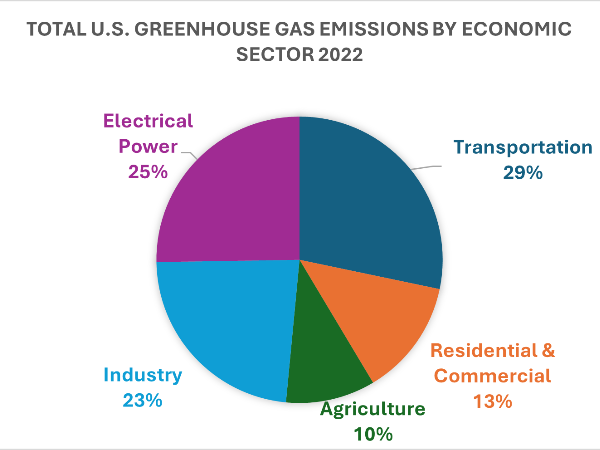The Earth’s climate is changing rapidly due to greenhouse gas (GHG) emissions, primarily carbon dioxide, trapping heat in the atmosphere. As the world’s largest economy, the United States plays a significant role in global GHG emissions. However, recent efforts aim to reduce these emissions and transition towards a cleaner future. The following are the major sources of GHG in the USA.
Transportation Emissions:
Transportation remains a major contributor to U.S. emissions, primarily from cars, trucks, and airplanes. While the Environmental Protection Agency (EPA) doesn’t have finalized data for 2023 yet, preliminary reports from the Rhodium Group suggest a promising trend.
- 2022: Transportation emissions decreased by 0.21% compared to 2021, reaching an estimated 1,801.47 million metric tons of CO2e (source: EPA).
- 2023 (estimated): Emissions are projected to decline by 1.8% compared to 2022, potentially reaching 1,768.41 million metric tons of CO2e (source: Rhodium Group).
These trends suggest potential progress towards a sustainable transportation, but achieving significant reductions requires continued investment in public transport and green transportation sources.
Electricity Generation:
The way we generate electricity significantly impacts emissions. Here’s how things are shaping up:
- 2022: Emissions from electricity generation decreased by 0.43% to an estimated 1,577 million metric tons of CO2e (source: EPA). This decline can linked to low electricity demand due to the closure of industries, markets, commercial sectors, and educational institutes during the COVID breakout.
- 2023: The EPA doesn’t have finalized data yet, but the U.S. Energy Information Administration reports a decrease in energy-related CO2 emissions in 2023 compared to 2022. This decline is largely due to a shift away from coal-fired electricity generation and increased reliance on solar power.
Industry’s Role:
Industrial processes are another significant source of emissions. Here’s a look at the recent trends:
- 2022: Industrial emissions decreased by 0.22% to an estimated 1452.54 million metric tons of CO2e (source: EPA). This decrease can be attributed to COVID closure, improvements in energy efficiency, and changes in industrial practices.
- 2023: Data for 2023 is not available yet, however, continued innovation and adoption of cleaner technologies in the industrial sector are crucial for sustained reductions.
The following table shows the U.S. Emissions by Economic Sector, MMT CO2 eq for the years range from 2015 to 2022. Also, the graph shows the total U.S. Greenhouse Gas Emissions by Economic Sector in 2022.

The Road Ahead:
- Clean energy technologies: Investing in solar, wind, and other renewable sources will significantly reduce emissions from the electricity sector.
- Transportation electrification: Promoting electric vehicles and public transportation can dramatically reduce emissions in the transportation sector.
- Industrial innovation: Supporting research and development of cleaner industrial processes can further reduce emissions.
By addressing these areas, the United States can contribute significantly to mitigating climate change and ensuring a sustainable future. Next, we will be discussing GHG emissions in the state of Idaho, and will cover how multiple sectors like transport, agriculture, energy generation, and industrial sectors are contributing towards GHG emissions in Idaho. Have any questions or want to know more about GHG emissions in the United States or Idaho? Let us know at COBEEthics@boisestate.edu!
This article utilized data from the following sources: